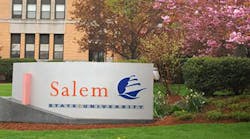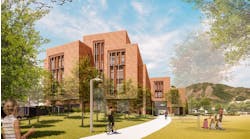Salem State University has received a $193,500 grant from the state of Massachusetts for the installation of three rooftop solar systems totaling 387 kilowatts.
The solar panels at the Berry Library, Marsh Hall, and Gassett Fitness Center on the Salem campus are projected to save the university $28,500 in annual electricity costs and generate 439,000 kilowatt hours of electricity over 20 years.
The grant marks the first award under the $5 million solar grant program launched earlier this year by the state's Department of Energy Resources to encourage solar development at state entities.
“Our administration is investing in solar development at state entities because expanding solar infrastructure using our existing state assets is a prime opportunity to maximize our renewable energy generation, lower emissions and reduce costs,” says Governor Charlie Baker. “The Commonwealth’s public colleges and universities continue to go the extra mile to support Massachusetts’ clean energy leadership and these projects at Salem State University will benefit the environment and save money, while the campus leads by example for its students and the surrounding community.”
These projects will reduce the university’s electricity costs for the portion of electricity generated by these solar arrays by about 45 percent from about $0.14 per kWh to $0.08 per kWh.
The Department of Energy Resources' Leading by Example Solar Grant works with state agencies to meet specific targets for greenhouse-gas emission reductions, energy consumption reduction and renewable energy procurements.
“I commend Salem State University for their environmental leadership and commitment to reduce our collective energy use,” said Secretary of Energy and Environmental Affairs Matthew Beaton. “This grant is a win-win that will allow the school to operate more efficiently while reducing expenses.”
The solar installations add to a wide-ranging sustainability initiative at Salem State. That includes an existing 216 kilowatts of solar panels, four electric vehicle charging stations, five LEED-certified buildings, an EPA award-winning compost program, and 22% percent reduction in campus water use from 2014 to 2017.
“We are grateful for this significant investment from the state, which will triple the amount of solar power we have on our campus,” says Salem State University President John Keenan.“Salem State has proudly signed on to Second Nature’s Presidents’ Climate Commitment to be carbon neutral by 2050, and these solar installations are critical as we work toward that goal. Advancing our sustainability goals is not only the right thing to do for our planet, but it also supports our efforts to contain costs for our students.”
Since 2007, state agencies and public higher education campuses have made significant sustainability improvements, including collectively reducing greenhouse gas emissions by 28 percent, generating 20 percent of electricity demand from onsite renewable and combined heat and power sources, installing 23 megawatts of solar capacity, reducing heating oil use by 84 percent, and installing 119 electric vehicle charging stations.


